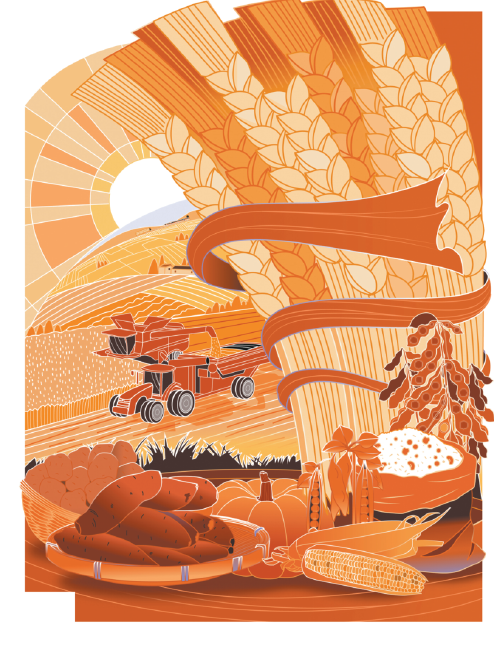Steps taken to ensure food security
Nation continues push to decrease reliance on grain imports by developing new crop varieties
By Li Lei in Beijing, Wu Yong in Shenyang,Wu Yong and Zhu Xingxin in Taiyuan | China Daily | Updated: 2024-09-20 06:56

Boasting over half of the country's soybean production, Northeast China's soybeans are renowned for their exceptional quality, thanks to a significant day-night temperature difference that provides a unique advantage in cultivation.
In the heart of the soybean belt lies Liaoning province and the Soybean Research Institute of Shenyang Agricultural University.
Focused on tackling critical bottlenecks in China's soybean production, the institute in recent years has bred 23 new soybean varieties, including two approved for commercial production by national authorities.
Collaborating actively with renowned research bodies such as the Chinese Academy of Agricultural Sciences and the Liaoning Academy of Agricultural Sciences, the institute has curated over 3,000 soybean germplasm resources from home and abroad. These resources are crucial to developing better-performing varieties.
Shennong 12, a nationally approved high-yielding and high-oil variety developed by the institute, has shattered yield records, surpassing 4.5 metric tons per hectare in trials in Liaoning.
"Its exceptional adaptability to high-density planting has transformed planting practices in the region, with densities soaring from 150,000 to 450,000 plants per hectare," the institute said in a statement provided to China Daily.
Authorities have long leaned on imported soybeans to make animal feed and cooking oil while focusing on achieving self-sufficiency in staple crops such as rice and wheat.
However, vulnerabilities in the global supply chain, among other factors, have prompted the Chinese government to ramp up domestic soybean production through the deployment of higher-yield varieties and expanding planting areas.
China imported 160 million tons of grain last year, with soybean accounting for 99.4 million tons, official data showed.
The country will reduce its soybean imports to 78.6 million tons by 2033, according to the China Agricultural Outlook 2024-33 report, which was compiled by the Ministry of Agriculture and Rural Affairs' market early warning expert committee, and released in April.
Production plan
The National Development and Reform Commission, China's top economic planner, unveiled a plan in the first half of the year, aiming to boost the country's annual food production by over 50 million tons by 2030, focusing on corn and soybean.
Co-drafted by the NDRC and the Ministry of Agriculture and Rural Affairs, the plan made clear the resolve to discourage nonagricultural use of farmland and maintain food-growing areas at around 116.7 million hectares by 2030, similar to current levels.
The plan targets grain productivity surpassing 6.3 tons per hectare by 2030, up from 5.8 tons last year.
It also emphasizes priorities such as enhancing rice and wheat quality through optimized variety structures, increasing corn productivity and expanding soybean cultivation areas.
Despite producing over 650 million tons of grain annually and being largely self-sufficient in staple crops like rice and wheat, China heavily relies on soybean imports from Brazil and the United States.
Corn and soybeans are essential raw materials for animal feed production.
In recent years, authorities have launched a campaign to boost productivity in 200 corn-growing counties and 100 soybean-growing counties.
This initiative includes promoting high-density planting varieties and enhancing crop management practices to reduce food loss to diseases and pests.
A mix of crop rotation and intercropping methods has been employed to expand soybean cultivation.
Boosting yields
As part of the plan, the NDRC will designate 720 counties across the nation as "key zones" for advancing the target over the next six years.
They are expected to see the ramping up of efforts to build irrigation facilities and high-standard farmland suitable for large mechanical farming and more resilient to climate change, which some experts believe could also drive investment and help the economy recover from the lingering impact of the COVID-19 pandemic.
Initiatives will also be launched to bolster the quality and supply of crop seeds, especially those of better-performing food varieties.
One example is a 15-hectare experimental wheat field located in the Jinzhong National Agriculture High-tech Industries Demonstration Zone in Shanxi province. The field has been planted with Jinzuo 84, a pioneering organic dryland variety of wheat.
Last year, Jinzuo 84 yielded an impressive 12 tons per hectare, surpassing the control group of ordinary varieties, which yielded around 5.25 tons per hectare.
Jinzuo 84 wheat is the outcome of over a decade of breeding efforts by Shanxi Agricultural University. This innovative variety seamlessly combines the exceptional cold resistance of northern wheat varieties with the high productivity of coastal varieties.
Yun Weihua, deputy director of the demonstration zone's management committee, said the variety's ability to yield 12 tons per hectare while using 40 percent less water not only has huge potential to benefit China's food security, but also places with relative food insecurity such as Africa.
"I am confident that these outstanding varieties can be effectively promoted on an international scale," Yun said.
Another example of successfully boosting yields can be found in Dezhou, Shandong province.
Dezhou, situated in the northwestern part of Shandong within the renowned "Golden Wheat Belt", boasts flat terrain, fertile soil and favorable climate conditions.
The city produces about 1 percent of the national annual output of wheat and one-sixth of Shandong's.
As a significant grain-producing hub, Dezhou has been steadfast in its efforts to stabilize total production and enhance productivity.
In 2021, the city embarked on an initiative aiming to achieve a target yield of over 1,500 kilograms per mu (one hectare is 15 mu) within a five-year timeframe.
As of last year, most of its grainfields had reached the target.
"Seeds are the chips of agriculture and key for Shandong to achieve the 1,500-kilogram-per-mu target," said Liu Junsheng, chairman of Shandong Liangxing Seed Industry Co, whose development of high-yield, premium-quality wheat and corn varieties, along with innovative high-yield technologies, has significantly contributed to Dezhou's success.
Among these varieties, Liangxing 77 stands out as Shandong's premier wheat variety, renowned for its suitability for mechanical harvesting.
Reducing imports
The plan to increase annual food production by over 50 million tons by 2030 is part of the national move to build the country into an agricultural powerhouse through efforts such as preserving growing areas, promoting mechanical farming and popularizing higher-yield varieties.
Official figures show that China's annual grain yield has remained above 650 million tons for the past nine years. The per capita food stockpile was 493 kilograms last year, well above the international food security threshold of 400 kg.
On multiple occasions, officials have reassured the public that China's food supply is stable and secure, while stressing the need to further raise productivity and output in the face of growing demand for animal proteins and pointing out the vulnerabilities in global supply chains.
An unnamed official told Xinhua News Agency recently that overall national food security is guaranteed.
However, the official said: "The tight balance between grain supply and demand will exist for a long time. In the coming period, the existing gap between production and demand may further expand (if nothing is done)."
To make sure the output target is reached on time, the plan says food production and farmland preservation are politically important tasks for local officials and calls for multichannel funding for related work, the official said, adding that it also proposes measures to incentivize planting, streamline agricultural loans and improve food storage and transportation infrastructure.
Officials said at a news conference last month that the summer grain and early rice have been harvested, and the overall growth of autumn grain is normal. The supply of farm produce is sufficient, providing the foundation and confidence for this year's Chinese Farmers' Harvest Festival — which falls on Sept 22, the Autumnal Equinox.
Established in 2018 as the first national holiday dedicated to farmers, this year's event will showcase the country's accomplishments in agricultural and rural development.
China's grain yield will grow at an annual pace of 1.1 percent over the coming decade as hunger rises worldwide, enabling the world's largest food importer to buy significantly less from overseas, according to China Agricultural Outlook 2024-33.
The country's annual crop output is projected to reach 704 million tons this year, up from 695 million tons last year, and is expected to top 766 million tons by 2033 thanks to stable growing areas and increased productivity, it said.
The report said that by 2033, each hectare of farmland in China would be able to produce an average of 6.43 tons of food, compared with the current level of around 5.83 tons, allowing the country to meet 91.5 percent of its food needs.
China's crop imports would decrease to 110 million tons in 2033, it said.
The rosy estimates in the report come as China promotes "new quality productive forces" — elements and reforms that can drive strategic emerging industries and boost productivity.
Chinese Academy of Agricultural Sciences Party chief Yang Zhenhai said that, as part of that drive, the academy will focus on basic research and "key core technological breakthroughs" in areas such as gene editing, synthetic biology, digital intelligence and green technology.
"Developing new quality productive forces is the latest deployment made by the central authorities to promote high-quality development overall," he said.
Sheikh Ahaduzzaman, a China representative at the United Nations' Food and Agriculture Organization, said that the world is falling behind in efforts to meet the UN's goal of ending world hunger by 2030, and China has been a stabilizer for the global food market.
UN data showed that by 2022, around 735 million people — or 9.2 percent of the world's population — lived with chronic hunger, which the UN said was a "staggering rise" from the pre-pandemic level in 2019.
Another 2.4 billion people faced moderate to severe food insecurity, meaning they lacked sufficient nourishment, up 391 million from 2019, the UN said.
Contact the writers at lilei@chinadaily.com.cn
























